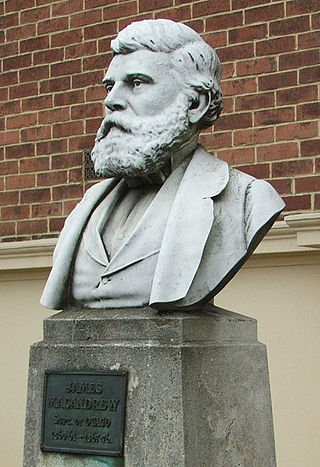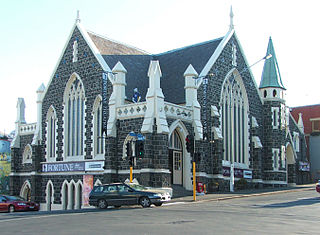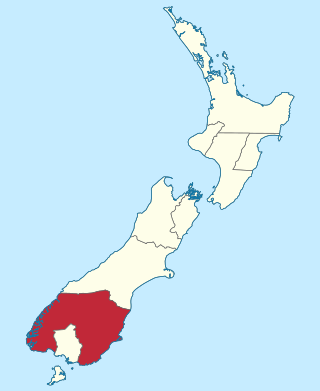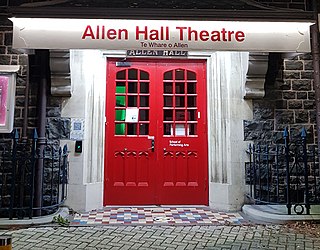
Oamaru is the largest town in North Otago, in the South Island of New Zealand, it is the main town in the Waitaki District. It is 80 kilometres (50 mi) south of Timaru and 120 kilometres (75 mi) north of Dunedin on the Pacific coast; State Highway 1 and the railway Main South Line connect it to both cities. With a population of 14,000, Oamaru is the 28th largest urban area in New Zealand, and the third largest in Otago behind Dunedin and Queenstown. The town is the seat of Waitaki District, which includes the surrounding towns of Kurow, Weston, Palmerston, and Hampden, which combined have a total population of 23,200.

Dunedin is the second-largest city in the South Island of New Zealand, and the principal city of the Otago region. Its name comes from Dùn Èideann, the Scottish Gaelic name for Edinburgh, the capital of Scotland. The city has a rich Māori, Scottish, and Chinese heritage.

James Macandrew was a New Zealand ship-owner and politician. He served as a Member of Parliament from 1853 to 1887 and as the last Superintendent of Otago Province.

Larnach Castle is a mock castle on the ridge of the Otago Peninsula within the limits of the city of Dunedin, New Zealand, close to the small settlement of Pukehiki. It is one of a few houses of this scale in New Zealand. The house was built by the prominent entrepreneur and politician, William Larnach. Since 1967, the castle has been privately owned by the Barker family, and opened as a tourist attraction, as "New Zealand's only castle".

William Walter Cargill was the founder of the Otago settlement in New Zealand, after serving as an officer in the British Army. He was a member of parliament and Otago's first Superintendent.

New Zealand's Fortune Theatre laid claim to being the world's southernmost professional theatre company and sole year round professional theatre group in Dunedin, until its closure on 1 May 2018, citing financial difficulties. The company ran for 44 years. The theatre regularly produced local shows and hosted touring performances.

The Octagon is the city centre of Dunedin, in the South Island of New Zealand. It is an eight-sided plaza with a circular one-way carriageway, bisected by the city's main street, and is also the central terminus of two other main thoroughfares. The Octagon is predominantly a pedestrian reserve, with grass and paved features, and is surmounted by a statue of the Scottish poet Robert Burns. Several of Dunedin's significant buildings and institutions adjoin the plaza, which is also a major hub for public transport in Dunedin, primarily taxi services.

Princes Street is a major street in Dunedin, the second largest city in the South Island of New Zealand. It runs south-southwest for two kilometres from The Octagon in the city centre to the Oval sports ground, close to the city's Southern Cemetery. North of The Octagon, George Street continues the line of Princes Street north-northeast for two and a half kilometres. Princes Street is straight but undulating, skirting the edge of the City Rise to its northwest. The part of the street immediately below The Octagon is the steepest section, as the road traverses an old cutting through Bell Hill.

The Otago Province was a province of New Zealand until the abolition of provincial government in 1876. The capital of the province was Dunedin. Southland Province split from Otago in 1861, but became part of the province again in 1870.

South Dunedin is a major inner city suburb of the New Zealand city of Dunedin. It is located, as its name suggests, 2.5 kilometres (1.6 mi) to the south of the city centre, on part of a large plain known locally simply as "The Flat". The suburb is a mix of industrial, retail, and predominantly lower-quality residential properties.
Scottish New Zealanders are New Zealanders of Scottish ancestry or who originate from Scotland. The number of New Zealanders who are descended from Scots is unknown, as the New Zealand census asks for ethnicity, not ancestry, and most have now assimilated; nonetheless, the vast majority of Pākehā, or European New Zealanders are of British and Irish descent, and it has been estimated that 1-2 million New Zealanders have roots in Scotland. This includes many Māori, as a large proportion of which have European roots as well. Most Scottish New Zealanders live in New Zealand's deep southern regions of Otago and Southland, New Zealand, where they have had a substantial influence. Scottish influence on Dunedin, one of New Zealand's most historically important cities was profound, and Presbyterianism is the major religion south of Christchurch. In some parts of Otago but all of Murihiku, there is a distinct accent known as the "Southland Brrr", which differs from mainstream New Zealand English for being strongly rhotic.
Bruce was a rural parliamentary electorate in the Otago region of New Zealand, from 1861 to 1922. For part of the 1860s with the influx to Otago of gold-miners it was a multi-member constituency with two members.
The Otago Witness was a prominent illustrated weekly newspaper in the early years of the European settlement of New Zealand, produced in Dunedin, the provincial capital of Otago. Published weekly, it existed from 1851 to 1932. The introduction of the Otago Daily Times, followed by other daily newspapers in its circulation area, led it to focus on serving a rural readership in the lower South Island, where poor road access prevented newspapers being delivered daily. It also provided an outlet for local fiction writers. It is notable as the first newspaper to use illustrations and photographs and was the first New Zealand newspaper to provide a correspondence column for children, which was known as "Dot's Little Folk". Together with the Auckland-based Weekly News and the Wellington-based New Zealand Free Lance it was one of the most significant illustrated weekly New Zealand newspapers in the 19th and early 20th centuries.
The Bruce by-election 1862 was a by-election held in the multi-member Bruce electorate during the 3rd New Zealand Parliament, on 31 July 1862. The by-election was caused by the death of incumbent MP Charles Kettle on 5 June, and was won by Edward Cargill.
The 1859 Town of Dunedin by-election was a New Zealand by-election held in the single-member electorate of Town of Dunedin during the 2nd New Zealand Parliament on 14 January 1859, after the resignation of James Macandrew. The election was won by Macandrew, who had resigned from his seat on 2 November 1858 as a result of not attending a parliamentary session earlier in his term.

Henry Thomas Mandeno was a New Zealand modernist architect.

The PlayhouseTheatre is a theatre in Dunedin, New Zealand. It was converted from a lodge into a 100-seat theatre by the Southern Comedy Players in 1962. Since the late 1960s it has been home to the Dunedin Repertory Society, who regularly perform youth productions for children.

Allen Hall, also known as the Allen Hall Theatre, is a building at the University of Otago in Dunedin, New Zealand. It is named after James Allen, Vice-Chancellor and then Chancellor of the university, who was instrumental in raising funds for building the hall. Originally the student association building, opened in 1914, the hall now operates as a theatre. Allen Hall is known for the series of Lunchtime Theatre performances. The hall and archway are registered as a Category I historic place by Heritage New Zealand.

Lisa Jadwiga Valentina Warrington is a New Zealand theatre studies academic, director, actor and author. She has directed more than 130 productions, and established the Theatre Aotearoa database. In 2014 she was awarded a Lifetime Achievement Award in the Dunedin Theatre Awards, and was three times winner of a New Zealand Listener Best Director award, including one for Tom Scott's The Daylight Atheist.

The former Trinity Methodist Church is registered as a category I historic place by Heritage New Zealand, which recognises its historic and architectural significance. Originally a Methodist church, it is located on the corner of Moray Place and Upper Stuart Street, in the heart of the southern city of Dunedin. In 1977 the church was refitted and operated as the Fortune Theatre.
















